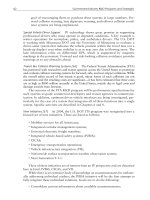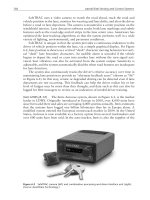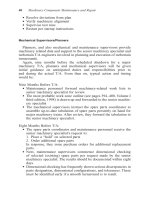Applications of Robotics and Artificial Intelligence to Reduce Risk and Improve Effectiveness 1 Part 5 ppsx
Bạn đang xem bản rút gọn của tài liệu. Xem và tải ngay bản đầy đủ của tài liệu tại đây (1.22 MB, 20 trang )
APPLICATIONS OF ROBOTICS AND ARTIFICIAL INTELLIGENCE
Get any book for free on: www.Abika.com
81
79
80
APPLICATIONS OF ROBOTICS AND ARTIFICIAL INTELLIGENCE
Get any book for free on: www.Abika.com
82
81
82
APPLICATIONS OF ROBOTICS AND ARTIFICIAL INTELLIGENCE
Get any book for free on: www.Abika.com
83
81
84
APPLICATIONS OF ROBOTICS AND ARTIFICIAL INTELLIGENCE
Get any book for free on: www.Abika.com
84
85
APPLICATIONS OF ROBOTICS AND ARTIFICIAL INTELLIGENCE
Get any book for free on: www.Abika.com
85
86
REFERENCES
1. National Bureau of Standards. 1980. Proceedings of NBS/Air Force ICAM Workshop on
Robot Interfaces, June 4-6. NBSIR 80-2152.
2. Taylor, R. H., P. D. Summers, and J. M. Meyer. 1982. AML: A Manufacturing Language.
International Journal of Robotics Research l(3):19-41.
3. Birk, J. and R. Kelley, eds. 1980. Research Needed to Advance the State of
Knowledge in Robotics. Kingston: Rhode Island University.
4. Roth, B. Kinematic Design for Manipulation, in [3], pp. 110-118.
5. Dubowsky, S. Dynamics for Manipulation, in [3], pp. 119-128.
6. Houston, R. Compliance in Manipulation Links and Joints, in [3], pp. 129-145.
7. Paul, R. P. 1981. Robot Manipulators Mathematics Programming and Control.
Cambridge, Mass.: MIT Press.
8. Brady, M. and J. Hollerbach. 1982. Robot Motion: Planning and Control. Cambridge,
Mass.: MIT Press.
9. Toepperwein, L. L., M. T. Blackmon, R. Fukui, W. T. Park, and B. Pollard. 1980. ICAM
Robotics Applications Guide. Vol. II. Technical Report AFWAL-TR-80-4042.
10. Salisbury, J. K. and J. Craig. 1982. Articulated Hands: Force Control and Kinematic Issues.
International Journal of Robotics Research l(l):4-17.
11. Hollerbach, J. M. 1982. Workshop on Dexterous Hands. MIT AI Memo.
12. Orin, D. E. 1982. Supervisory Control of a Multilegged Robot. International Journal of
Robotics Research 1(1):79-91.
87
13. Gleason, G. J. and G. Again. 1979. A Modular Vision System For Sensor Control
Manipulation and Inspection. SRI Report, Project 4391. SRI International.
14. Lavin, M. A. and L. I. Lieberman. 1982. AML/V: An Industrial Machine Vision System.
International Journal of Robotics Research 1(3):42-56.
APPLICATIONS OF ROBOTICS AND ARTIFICIAL INTELLIGENCE
Get any book for free on: www.Abika.com
86
15. Nagel, R. N., et al. 1979. Experiments in Part Acquisition Using Robot Vision.
SME Technical Paper MS 79-784.
16. Brady, M. 1982. Computational Approaches to Image Understanding. Computing Surveys
14:4-71.
17. Nevins, J. L., et al. Exploratory Research in Industrial Assembly and Part
Mating. Report No. R-1276. Cambridge, Mass.: Charles Stark Draper Laboratory. 193 pp.
18. Harmon, L. D. 1982. Automated Tactile Sensing. International Journal of Robotics
Research 1(2):3-32.
19. Bejczy, A. K. 1979. Manipulator Control Automation Using Smart Sensors. Paper delivered
at Electro/79 Conference, New York, April 24-26.
20. Raibert, M. H. and J. E. Tanner. 1982. Design and Analysis of a VLSI Tactile Sensor.
International Journal of Robotics Research. l(3):3-18.
21. Hillis, W. D. 1982. A High Resolution Image Touch Sensor. International Journal of
Robotics Research. l(2):33-44.
22. Albus, J. S., A. J. Barbera, M. L. Fitzgerald, R. N. Nagel, G. J. VanderBrug, and T. E.
Wheatley. 1980. Measurement and Control Model for Adaptive Robots. Pp. 447-466 in
Proceedings, 10th International Symposium on Industrial Robots, Milan, Italy,
March 5-7.
23. Nagel, R. N., et al. 1982. Connecting the Puma Robot With the MIC Vision System and
Other Sensors. Pp.447-466 in Robot VI Conference Proceedings, Detroit, March 2-4.
24. D. R. Brown, et al. 1982. R&D Plan for Army Applications of AI/Robotics. SRI
Project 3736. SRI International. 324 pp.
25. Nau, D. S. 1982. Expert Computer Systems and Their Applicability to Automated
Manufacturing. NBSIR 81-2466.
26. Charniak, E., and Y. Wilks, eds. 1976. Computational Semantics: An Introduction to
Artificial Intelligence and Natural Language Comprehension. Amsterdam: North
Holland Publishing Co.
88
27. Lehnert, W., and M. Ringle, eds. 1982. Strategies for Natural Language Processing.
Hillsdale, N.J.: Lawrence Erlbaum Associates.
APPLICATIONS OF ROBOTICS AND ARTIFICIAL INTELLIGENCE
Get any book for free on: www.Abika.com
87
28. Nilsson, N. J. 1971. Problem Solving Methods in Artificial Intelligence. New
York: McGraw-Hill.
29. Schank, R., and R. Abelson. 1977. Scripts, Plans, Goals and Understanding.
Hillsdale, N.J.: Lawrence Erlbaum Associates.
30. Waltz, D. L. 1982. Artificial Intelligence. Scientific American. 247(4):118-133.
31. Winston, P. H. 1977. Artificial Intelligence. Reading, Pa.: Addison Wesley.
32. Proceedings for the Conference on Applied Natural Language Processing, Santa
Monica, Calif., February 1983.
33. Proceedings for the Association of Artificial Intelligence Conference on
Artificial Intelligence (IJCAI 1969, 1973, 1975, 1977, 1979, 1981).
34. Ballard, D. H. and C. M. Brown. 1982. Computer Vision. Englewood Cliffs, N.J.: Prentice-
Hall.
35. Rosenfeld, A. 1983. Picture Processing: 1982. Computer Science Technical Report.
College Park: University of Maryland.
36. Dennicoff, M. 1982. Robotics in Japan. Washington, D.C Office of Naval Research.
37. Raibert, M., and J. Craig. 1981. Hybrid Controller. IEEE Systems Management
Cybernetics.
38. Barr, A., and E. A. Feigenbaum, eds. 1981, 1982. Handbook of Artificial
Intelligence, vols. I-III. Stanford, Calif.: HeurisTech Press.
39. State of the Art of Vision in Japan, IEEE Computer Magazine (13) 1980.
GLOSSARY OF ACRONYMS
AFOSR Air Force Office of Scientific Research
AI artificial intelligence
AML manufacturing language developed at IBM
AMRDC U.S. Army Medical Research and Development Command
ASB Army Science Board
ASP Automated Ammunition Supply Point
ATE automatic test equipment
BITE built-in test equipment
C
3
I command, control, communication, and intelligence
APPLICATIONS OF ROBOTICS AND ARTIFICIAL INTELLIGENCE
Get any book for free on: www.Abika.com
88
CAD/CAM computer-aided design and manufacturing
CAI computer-aided instruction
CARP computer-aided robot programming
CMU Carnegie-Mellon University
CPU central processing unit
CRT cathode ray tube
DARPA Defense Advanced Research Projects Agency
DART expert system for the diagnosis of equipment failure
DEC Digital Equipment Corporation
DMA Defense Mapping Agency
ES expert system
FLIR forward-looking infrared
FMS flexible manufacturing system
GE General Electric Company
GM General Motors Corporation
Hawk-Missile CAI trainer at Fort Bliss Air Defense School
ICAM Integrated Computer-Aided Manufacturing program of the U.S. Air Force
IR industrial robot
IRCC
instrumented remote center of compliance developed at Draper
Laboratories
JPL Jet Propulsion Laboratory
MACSYMA symbolic mathematics expert system
90
MCL computer language developed at McDonnell Douglas
MIC Machine Intelligence Corporation
MIT Massachusetts Institute of Technology
MYCIN production system for diagnosis and treatment of infectious diseases
NBC nuclear, biological, and chemical
NBS National Bureau of Standards
NSF National Science Foundation
ONR Office of Naval Research
Prospector expert system to aid in exploration for minerals
APPLICATIONS OF ROBOTICS AND ARTIFICIAL INTELLIGENCE
Get any book for free on: www.Abika.com
89
PUFF pulmonary function diagnosis expert system
P
3
I preplanned product improvement
RAIL Pascal-based second generation language by IBM
RAMS reliability, availability, maintainability,and supportability
R&D research and development
REMBASS remotely monitored battlefield sensor system
RIA Robot Institute of America
RPI Rensselaer Polytechnic Institute
SAR synthetic aperture radar
SRI Stanford Research Institute
VAL language developed by Unimation for Puma robot
VHF very high frequency
VHSIC Very High Speed Integrated Circuits
VIMAD
Voice Interactive Maintenance Assistance Development system
(supported by DARPA)
VLSI very large-scale integration
VTRONICS
set of projects for onboard, embedded sensing of vehicular malfunctions
with built-in test equipment (BITE)
91
1 BACKGROUND
Throughout its history, the Army has been manpower-intensive in
most of its systems. The combination of demographic changes
(fewer young men), changed battlefield scenarios, and advanced
technologies in improved robotics, computers, and artificial
intelligence (AI) suggests both a need and an opportunity to
multiply the effectiveness of Army personnel. Not only can these
technologies reduce manpower requirements, they can also replace
personnel in hazardous areas, multiply combat power, improve
efficiency, and augment capabilities.
The Deputy Chief of Staff for Research, Development and
Acquisition authorized the National Research Council to form a
committee to review the state of AI and robotics technology,
predict developments, and recommend Army applications of Al and
robotics. This Committee on Army Robotics and Artificial
Intelligence brought together experts with military, industrial,
and academic research experience.
APPROACH
APPLICATIONS OF ROBOTICS AND ARTIFICIAL INTELLIGENCE
Get any book for free on: www.Abika.com
90
The committee began its work with a detailed review of the state
of the art in robotics and artificial intelligence as well as
with predictions of how the technology will develop during the
next 5- and 10-year periods. This review is summarized in
Chapter 2 and in its entirety forms the appendix of this report.
It is the foundation of the committee's recommendations for
selecting and implementing of applications.
The committee used its review of technology and information on
Army doctrine, prior reports on Army applications of AI and
robotics, and its combined military, university, and industrial
experience to develop criteria for selecting applications and to
recommend specific applications that it considers of value to
the Army and the country. For each application recommended, the
committee was asked to report the expected effects on personnel,
skills, and equipment, as well as to provide an implementation
strategy incorporating priorities, costs, timing, and a measure
of effectiveness.
PRIOR STUDIES
As background to its efforts, the committee was briefed on and
reviewed three studies completed during 1982 on Army robotics
and artificial intelligence:
D. R. Brown, et al., R&D Plan for Army Applications of
AI/Robotics, SRI International, May 1982 (Contract No. DAAK7O-
81-C-0250, U.S. Army Engineer Topographic Laboratories).
Army Plan for AI/Robotics Technology Demonstrators, Department
of the Army, June 1982.
Report of the Army Science Board Ad Hoc Subgroup on Artificial
Intelligence and Robotics, Army Science Board, September 1982.
Each contributes to the base of knowledge regarding these
expanding new technologies and offers insights into potential
applications to enhance the Army's combat capabilities. Their
conclusions are briefly reviewed here to place the contribution
of this particular report in a proper context.
R&D Plan for Army Applications of AI/Robotics
The report by SRI cites as the primary motivation for the
application of AI and robotics to Army systems the need to
conserve manpower in both combat and noncombat operations. It
covers more than 100 possible Army applications of AI and
APPLICATIONS OF ROBOTICS AND ARTIFICIAL INTELLIGENCE
Get any book for free on: www.Abika.com
91
robotics, classified into combat, combat support, and combat
service support categories. Many of the applications, though
listed as distinct, could easily be drawn together to serve as
generic applications. The report focuses on the need to document
justification for the value of AI and robotics in Army
applications in general, but the committee found that it lacked
sufficient detail for ranking the many applications to pursue
those of greatest interest and potential payoff.
From the 100 specific concepts that the SRI study considered, 10
broad categories of application were selected. An example from
each of these 10 categories was chosen for further study to
identify technology gaps and provide the basis for the research
plan recommended by the study.
Included in that plan were 5 fundamental research areas, 97
specific research topics, and 8 system considerations. Most
potential applications were judged to require advancement of the
technology base (basic research and exploratory development)
before advanced development could begin. In fact, the study
estimated that development on only four could be started in the
next 10 years, and two would require deferral of development
until the year 2000.
A briefing on the Army Proposed Plan was given to the committee
at its initial meeting. The report identified five projects for
application of AI or robotics technology to demonstrate the
Army's ability to exploit AI and robotics:
Robotic Reconnaissance Vehicle with Terrain Analysis,
Automated Ammunition Supply Point (ASP),
Intelligent Integrated Vehicle Electronics,
AI-Based Maintenance Tutor,
AI-Based Medical System Development.
Of these five proposed demonstrations, technical availability
assessments placed one in the near term, one in the mid-to-far
term, and the other three in the far term. Cost estimates and
schedules appear optimistic to this committee, considering that
much of the effort was neither funded nor programmed at that
time.
Report of the Army Science board
APPLICATIONS OF ROBOTICS AND ARTIFICIAL INTELLIGENCE
Get any book for free on: www.Abika.com
92
Ad Hoc Subgroup on Artificial Intelligence and Robotics
The Army Science Board Ad Hoc Subgroup was established to
provide an assessment of the state of the art of AI and robotics
as fast-track technologies and of their potential to meet Army
needs. It concentrated its efforts on those aspects with which
it could deal rapidly and relatively completely; it also
considered the five Army demonstrators and supported them.
The report grouped the five demonstrators into two categories:
proceed as is or proceed with modification. The subgroup
recommended changes to the maintenance tutor and the medical
system, and recommended that the other three demonstrators
proceed as planned. Other battlefield technology topics
recommended were automatic (robotic) weapons, automatic pattern
recognition, and expert support systems.
Noting that the introduction of technology into weapon systems
could be hampered by management problems, the subgroup
recommended establishing a single dedicated proponent of AI and
robotics in the Department of the Army, giving preference to
existing equipment and technology, and creating an oversight
committee from the Army's materiel developer and user
communities.
The subgroup tied its recommendations to the five technology
thrusts that the Army has designated to receive the majority of
research and development funds (lines 6.1, 6.2, and 6.3a of the
budget) during the next five-year funding period:
Very Intelligent Surveillance and Target Acquisition,
Distributed C31,
Self-Contained Munitions,
Soldier/Machine Interface,
Biotechnology.
CONTRIBUTION OF THIS REPORT
This committee is indebted to the foregoing efforts for the base
they provide, a base which this report attempts to expand. Our
recommendations are founded on a comprehensive assessment of the
state of the art and forecasts of technology growth over the
APPLICATIONS OF ROBOTICS AND ARTIFICIAL INTELLIGENCE
Get any book for free on: www.Abika.com
93
next 10 years. The details of that assessment are contained in
the Appendix. We hope that our recommendations to the Army will
provide a realistic technical assessment that will enable the
Army, in turn, to concentrate its efforts in areas offering the
most potential return.
No two groups considering possible AI and robotics applications
will have identical lists of priorities. This committee used the
combination of Army needs and the direction of technology
development as a guide in narrowing the list of possible
applications. The National Research Council is unique in the
diversity of backgrounds of the experts it brings together. The
members of this Committee on Army Robotics and Artificial
Intelligence have among them 248 years of industry experience,
110 years in academia, and 184 years in government. The
recommendations in this report are the consensus of the
committee, drawing on those years of experience.
We agree with the authors of studies we have reviewed that AI
and robotics technologies offer great potential to save lives,
money, and resources and to improve Army effectiveness. This
report will support the need for ongoing work in these high-
risk, high-technology fields that offer such great promise for
the country's future security help channel Army efforts into the
most effective areas, build understanding of what AI and robotics
can offer within the broad groups in the Army that will need to
work with these technologies ,
provide realistic information on what AI and robotics technology
can do now and the directions in which research is heading.
2 SUMMARY OF THE TECHNOLOGY
DEFINITIONS
We used the Robot Institute of America's
definition of a robot as
a reprogrammable multi-function manipulator
designed to move
material, parts, tools, or specialized
devices through variable
APPLICATIONS OF ROBOTICS AND ARTIFICIAL INTELLIGENCE
Get any book for free on: www.Abika.com
94
programmed motions for the performance of a
variety of tasks.
The main components of a robot are the
mechanical manipulator, which is a set of
links that determine the work envelope of
the robot and the ability to orient the
hand; the actuation mechanisms, which are
hydraulic, pneumatic, or electric; the
controller, usually a computer, which
controls motion by communicating with the
actuation mechanism.
The robot can be augmented by the addition
of end effectors, or "hands";
sensors, for performing measurements as
required to sense the environment,
including electromagnetic (visual,
infrared, ultraviolet, radar, radio, etc.),
acoustic, tactile, force, torque,
spectographic, and many others.
other "intelligent" functions, such as
understanding speech, problem solving, goal
seeking, and commonsense reasoning.
None of these, strictly speaking, is part
of the robot itself.
This chapter is a summary of the detailed
report on the state of the art and
predictions for AI and robotics technology
contained in the appendix.
APPLICATIONS OF ROBOTICS AND ARTIFICIAL INTELLIGENCE
Get any book for free on: www.Abika.com
95
Artificial intelligence, as defined in SRI
International's R&D Plan for Army
Applications of AI/Robotics, is the part of
computer science that is concerned with
symbol-manipulation processes that produce
intelligent action. By "intelligent action"
is meant an act or decision that is goal-
oriented, arrived at by an understandable
chain or symbolic analysis and reasoning
steps, and is one in which knowledge of the
world informs and guides the reasoning.
The functions or subfields of artificial
intelligence are natural-language
understanding; that is, understanding
English or another noncomputer language;
image understanding; that is, the ability
to identify what is in a picture or scene;
expert systems, which codify human
experience and use it to guide actions or
answer questions; knowledge acquisition and
representation;
heuristic search, a method of looking at a
problem and selecting a path to the
solution; deductive reasoning;planning,
which entails an initial plan for finding a
solution, then monitoring progress.
As this infant field develops, the list of
subfields will expand. Artificial
intelligence is the application of advanced
APPLICATIONS OF ROBOTICS AND ARTIFICIAL INTELLIGENCE
Get any book for free on: www.Abika.com
96
computer systems and software to these
areas, with "intelligent behavior" as the
intended result.
RESEARCH ISSUES
The categories of robotics research
receiving the most effort are
improvement of mechanical systems,
including manipulation design, actuation
systems, end effectors, and locomotion;
improvement of sensors to enable the robot
to react to changes in its
environment;creation of more sophisticated
control systems that can handle dexterity,
locomotion, and sensors, while being user
friendly.
In artificial intelligence, expert systems
is the area of research closest to being
ready to move from the laboratory to
initial commercial use.
Research on the kinematics of design,
models of dynamic behavior, and alternative
design structures, joints, and force
programming is leading to highly accurate
new robot structures. This research will
lead to robots capable of applying force
and torque with speed and accuracy and will
transform today's heavy, rigid, single
APPLICATIONS OF ROBOTICS AND ARTIFICIAL INTELLIGENCE
Get any book for free on: www.Abika.com
97
robotic arms into more lightweight,
ultimately more flexible arms capable of
coordinated motion.
Research on end effectors the hands
attached to a robot seeks to improve
dexterity, enabling robots to handle a
variety of parts or tools in complex
situations. Two goals are the quick-change
hand and the dexterous hand. The robot
would be able to charge a quick-change hand
by itself, attaching the means of
transmitting power as well as the physical
hand to the arm.
Although the dexterous hand is beyond the
current state of the art, there are some
interesting present approaches. One is a
variable finger selection; another is the
use of materials that will produce signals
proportional to surface pressures. This is
coupled with research in microelectronics
to analyze and summarize the signals from
these multisensored fingers for decision-
making outputs.
Early attention to locomotion has led to a
large number of robots in current use
mounted on tracks or an overhead gantry.
Progress has recently been made on a six-
legged walking robot that is stable on
three legs.
APPLICATIONS OF ROBOTICS AND ARTIFICIAL INTELLIGENCE
Get any book for free on: www.Abika.com
98
A middle ground between tracked and
unconstrained vehicles is a wire-guided
vehicle used in plants. These vehicles have
onboard microprocessors that communicate
with a central control computer at stations
placed along the factory floor. The
vehicles travel along a wire network that
is kept free of permanent obstacles; bumper
sensors prevent collisions with temporary
obstacles.
Sensors
The purpose of sensors is to give the robot
adaptive behavior that is, the ability to
respond to changes in its environment.
Vision and tactile sensors have received
the lion's share of research effort. While
tactile sensors are still fairly primitive,
vision systems are already commercially
available.
Vision systems enable robots to perform the
following types of tasks:
identification or verification of objects,
location of objects and their orientation,
inspection,
navigation and scene analysis,
APPLICATIONS OF ROBOTICS AND ARTIFICIAL INTELLIGENCE
Get any book for free on: www.Abika.com
99
guidance of the servo mechanism, which
controls position through feedback.
The first three tasks can be performed by
today's commercial systems. Three-
dimensional vision systems are at present
rudimentary.
Tactile sensors are just beginning to be
commercialized. Within the next few years,
force-sensing wrists and techniques for
controlling them will be available for such
tasks as tightening nuts, inserting shafts,
and packing objects. More research will be
needed before they can work in other than
benign environments.
Control Systems
The underlying research issue in control
systems is to broaden the scope of the
robot to include dexterous hands,
locomotion, sensors, and the ability to
perform new complex tasks.
Robots are typically programmed by either
the lead-through or the teach-box method.
In the former the controller samples the
location of each of the robot's axes
several times per second, while a person
manipulates the robot through the desired
motions. The teach-box method enables the
APPLICATIONS OF ROBOTICS AND ARTIFICIAL INTELLIGENCE
Get any book for free on: www.Abika.com
100
operator to use buttons, toggle switches,
or a joy stick to move the robot.
Programming languages for robots have long
been under research. Early robot languages
have combined language statements with use
of a teach box. Second-generation robot
languages, which resemble the standard
structured computer language, have only
recently become commercially available. It
is these second-generation robot languages
that create the potential to build
intelligent robots.
Expert Systems
Artificial intelligence has generated
several concepts that have led to the
development of important practical systems.
A subset of these systems has been called
expert systems. As the name suggests, an
expert system (ES) encodes deep expertise
in a narrow domain of human specialty.
Several expert systems have been
constructed whose behavior surpasses that
of humans. Examples include the MIT Macsyma
system (symbolic mathematics), the Digital
Equipment Corporation R-l system
(configuring VAX computers), the
Schlumberger dipmeter analyzer (oil well
logs), and various medical expert systems,
including PUFF (pulmonary function









